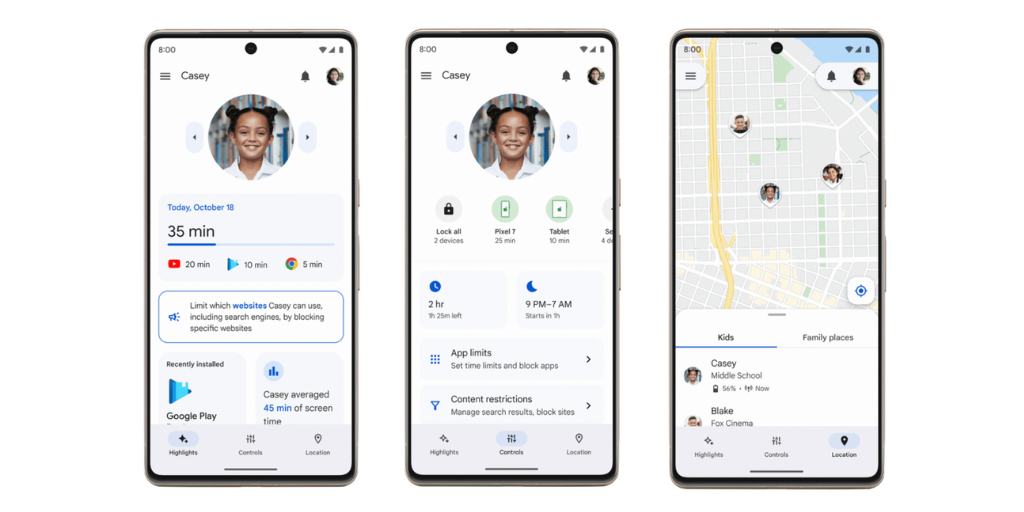
It will probably come as no shock that the majority of teens access pornography online. But what might surprise you is that teens aren’t just using Pornhub and incognito windows — they’re finding porn on social media, Spotify, X (formerly Twitter), and other unexpected places.
Read on to learn the many crafty ways teens seek out adult content and what parents can do about it.
From music apps to social media, here are some of the surprising ways your teen could find explicit content online.
Teens can locate pornographic content through the search feature on social media apps like Instagram and Snapchat. Despite content policies that prohibit explicit material, creators have sneaky ways of getting around filters. This includes:
X is probably the last place you’d expect to find your teen — and that’s kind of the point. It’s not an app that’s popular with Gen Z, so it’s not on most parents’ radars when it comes to setting parental controls.
Also, users don’t need to sign up for an account or download the app to use X, so kids can access it anonymously through their web browser. On X, teens don’t even need to use secret hashtag codes to find porn. X recently updated its policies to allow “consensually produced and distributed adult nudity or sexual behavior.”
Given that X is a text-based platform, pornographic content looks a little different. Some of the forms it might take include:
Teens can find porn on most music streaming platforms. (Spotify’s porn problem has made headlines.) Here’s how pornographic content may show up on these apps:
Reddit is another surprising hub for porn. Reddit has scores of discussion boards — known as subreddits — dedicated solely to pornographic content. Content labeled NSFW (not safe for work) indicates explicit material. Although some explicit subreddits have an age verification in place, it’s easy for teens to bypass the filter and fib about their age.
Curiosity about sex and sexual relationships are developmentally appropriate for teens. However, pornography can set unrealistic expectations and negatively impact attitudes about sex. So, parents need to be proactive in talking to their kids about the problems with porn.
Here are some steps you can take to protect your teen from online porn:
When you talk to your child about sensitive topics like sex, relationships, and drug and alcohol use, include porn in your discussions.
Discuss how it can give false, and sometimes dangerous, impressions about real-life sexual experiences. Be sure to talk about consent and the fact that porn often doesn’t model this in a healthy way.
If you’ve already discovered that your child is accessing porn, here are some tips for handling the situation.
Take advantage of parental controls to limit your child’s ability to access certain websites and explicit content. This should be done on devices, individual apps such as Instagram, and internet browsers.
BrightCanary is a monitoring service that uses advanced technology to analyze what your child messages, searches, and sends on all the apps they use on Apple devices. If your child sends explicit messages or searches for inappropriate material, BrightCanary will let you know with real-time concerning content alerts. There's even an option to monitor the images and videos they receive via texts.
Teens are finding porn online in many unexpected ways, including X, Reddit, and Spotify. Parents can take steps to prevent their teen from viewing age-inappropriate content, from talking openly about the risks of porn to using a monitoring app to supervise their child’s activity.
BrightCanary can help you monitor your child online. The app’s advanced technology scans what they send and search, including Google and social media, and alerts you when something concerning comes up. Download the app and get started for free today.

Parenting myths have a way of persisting, especially when it comes to raising kids in today’s tech-driven world. Some of those myths include the belief that all screen time is bad for kids and that a child is safe online as long as they don’t use social media. Breaking these misconceptions is a vital step toward keeping your child safe and healthy online.
Here are 7 myths of the most common digital parenting myths — and what you should know instead.
False. Social media poses some of the biggest risks to kids. But there are plenty of other places they may run into trouble online, such as inappropriate content on YouTube, online predators in forums, and cyberbullying in toxic group threads.
False. Parental controls are fantastic tools that can limit your child’s exposure to things you don’t want them to easily access. But they aren’t foolproof. They work best as part of a broader strategy that includes open communication and real-time monitoring.
False. The part of the brain responsible for impulse control and decision-making doesn’t fully develop until around age 25. Kids have a hard time resisting the instant gratification from using a device, and they’re limited in their ability to think about the consequences of their actions online.
False. Not all screen time is harmful because not all screen time is created equal. There are even potential benefits with educational apps, video chats with family, or creative tools like music and animation. The difference is whether screen time is active or passive.
False. Many kids hide their online issues out of fear of losing their device or getting in trouble. Consciously working to foster open communication with your child helps, but it’s still not a guarantee they won’t keep something important from you.
False. This myth continues to persist, despite ample research disproving that video games cause violent behavior. That said, it’s still important to stay involved in your child’s gaming habits and know what kind of content they’re consuming.
False. Your tech-savvy kid may be able to run circles around you when it comes to the technical side of things. But they lack the emotional maturity to navigate online threats like cyberbullying, grooming by predators, and misinformation. That’s where you come in.
There are many myths about parenting in the digital age that are downright false, such as believing if your child knows more about technology than you do, there’s nothing you can do to help them maneuver life online. It’s important for parents to bust these myths and educate themselves about the reality of raising kids in the era of the internet.
BrightCanary can help you supervise your child online. The app’s advanced technology scans their online activity (including social media, texts, YouTube, and Google searches) and updates when they encounter something concerning. Download the app and get started for free today.

Nudify apps are a disturbing use of artificial intelligence (AI) that parents need to be aware of. These apps can transform a regular, clothed photo into a realistic fake nude image — usually without the person’s consent. And, unfortunately, teens are using them.
In this guide, we’ll break down what nudify apps are, the risks, and what parents can do to keep their kids safe.
A nudify app is a type of software that uses AI to generate fake nude images by removing clothing from a photo. These apps typically train their algorithms using large datasets of explicit images scraped from the internet, which allows the app to recreate realistic human anatomy and create deepfake images that appear startlingly authentic.
Nudify apps pose serious emotional, reputational, legal, and digital risks, and the consequences can be long lasting. They include:
When a nudify app is used without a person’s consent and the resulting image is spread, the victim may feel violated, traumatized, and objectified. They may feel anxious about who might see the photo and unsafe at school if the perpetrators are classmates.
Because the images look so real, the person in the photo often suffers damage to their reputation when others think they posed consensually for the photo. (Yes, this is deeply unfair, but it’s unfortunately the way of the world, and parents and kids need to be aware.)
Once an image is online, it’s nearly impossible to fully erase. Even if it’s deleted, it’s often impossible to know if anyone printed, downloaded, or took a screenshot of the image. Images created on nudify apps may remain a part of a victim’s digital footprint indefinitely.
If your child creates or shares images made with a nudify app, they may be suspended, expelled from school, or kicked out of an extracurricular activity.
Nudify apps are new territory for schools, and many have been accused of being too soft with how they reprimand kids who create nude images of their peers.
Nude images of minors, even when they’re generated by AI, is illegal under federal law.
State laws vary, but kids have been charged with both misdemeanors and felonies. If found guilty, depending on the state, they may be required to register as a sex offender for the rest of their lives.
The best solution is prevention. Here are some steps you can take:
Because the risks of nudify apps are so great, it’s vital that parents talk to their children about the issue. Here are some talking points to get you started:
It’s never too young to teach consent — start early and refresh often. Be explicit that using nudify apps violates the consent of the person in the photo and is never okay.
Let them know there’s never any excuse for someone violating their consent in this way and that they should let you know if it ever happens.
Teach your children to be responsible digital citizens and think twice before they share anything online. If they suspect an image might be fake or if they think it might negatively impact the person in the picture, they shouldn’t share it. Instead, they should alert a trusted adult.
Be direct and clear about the potential consequences of using a nudify app or sharing images created with one. Kids aren’t always great about thinking about the long-term implications of their actions, and they need to know how serious the fallout could be if they use these apps.
Nudify apps use AI to turn clothed photos into fake nude images without the consent of the person in the picture. Use of these apps and websites can have devastating consequences for both the person in the image as well as the one who created it.
Parents need to educate their children on the risks and take steps to monitor their online activity so they can immediately take action if their child is involved in a situation using nudify apps.
BrightCanary can help you supervise your child online. The app’s advanced technology scans what they type and updates you in real-time when they encounter something concerning. BrightCanary provides the best coverage across Apple devices and online platforms where children are most at risk. Download the app for free today.

If you’re wondering whether an iPad is a smart choice for your child, you’re not alone. The iPad is one of the most popular tablets for kids thanks to its portability, educational apps, and long battery life — but it also comes with important considerations.
After all, with all the talk about the dangers of too much screen time, it can be hard to know if a tablet is the right choice for your kid. This guide will walk you through the pros and cons of iPads for kids, how to choose the best one, and how to set up an iPad with parental controls to ensure your child’s safety online.
As you decide if you should get your kid an iPad, one of the first things to do is to think about why you’re considering it and how you envision it being used.
Perhaps you’re looking for an easy-to-transport distraction for long car rides. Maybe you’re interested in educational apps for their enrichment potential. Or maybe you’re keen to make sure your child keeps up with their tech-savvy peers.
Identifying your motivation for getting a tablet for kids can help frame your decision as you weigh the pros and cons.
The American Academy of Pediatrics recommends no devices for children younger than 2, with the exception of video chatting. Even if your child is old enough, that doesn’t necessarily mean an iPad is right for them.
Here are some questions to ask yourself aside from age:
If you're ready to purchase, here are popular options parents often choose:
Tip: Refurbished iPads from Apple can be a great way to save money without sacrificing quality.
Once you’ve chosen a device, here’s how to make it safer:
Use Apple Family Sharing to set up an account for your child. This allows you to manage their settings and monitor usage.
Apple Screen Time lets you:
In Settings > Screen Time > Content & Privacy Restrictions, you can:
Apple’s built-in parental controls are helpful — but they don’t show you what your child is searching, watching, or texting.
BrightCanary fills that gap. With BrightCanary, you can:
While it’s always a good idea to maintain some level of supervision over your child’s iPad time, a child safety app like BrightCanary is an excellent complement to your watchful eye.
It’s best to set rules around iPad use from the very beginning. Be clear with your child about expectations and if there are consequences for not following them.
The rules you set will depend on what’s right for your family, but here are some to consider:
Once you’ve established your family’s rules around iPad use, consider writing it into a digital device contract.
The standard iPad (10th Gen) is a great balance of affordability and features. The iPad Mini is better for smaller hands, while older kids might benefit from the iPad Air.
Go to Settings > Screen Time to create limits on app usage, content restrictions, and communication safety settings. You can also use BrightCanary for more detailed monitoring.
The American Academy of Pediatrics recommends limited screen time for kids under 5 and no personal devices under age 2. Most experts suggest waiting until at least age 6 or 7.
It’s important that parents consider both the pros and the cons before getting their child an iPad and establish clear expectations around its use. A tablet is a connected device, and as such, it can expose your child to the entire world of the internet.
Parental control settings and monitoring apps can help give you peace of mind — and set a safety net for your child’s online experience. For the most comprehensive monitoring on Apple devices, including iPads for kids, you need BrightCanary. Get started for free today.

Fanfic, short for fan fiction, is a popular medium where fans write new stories based on existing works. Fanfic creators draw inspiration from books, television, movies, and video games. It’s a huge phenomenon that’s captured the attention of many teens. But what is fanfic, and what are fanfics used for?
If your child has latched onto the craze, consider this your primer. We’ll get into what fanfiction is, why it’s popular with teens, terms parents need to know, potential concerns, and how to help your child stay safe.
Fanfiction (or fanfic) is a genre of writing where fans use characters, settings, and plots from existing stories to create their own narratives. These stories often explore “what if” scenarios, new romances, alternate endings, or completely different worlds for familiar characters.
Fanfic originated in Star Trek fanzines in the 1960s. Then, in the ‘90s, when the internet exploded, fanfic really took off.
FanFiction.net gave fanfic writers a global platform to connect with readers, and other sites like Archive of Our Own (AO3) and Wattpad eventually followed.
Here are some of the reasons that people are drawn to write and read fanfic:
Fanfic is very jargon heavy. Here are some terms parents need to know:
For more fanfic terminology, check out this handy glossary.
Fanfic communities are most active on platforms like:
Many of these platforms have large teen audiences and offer both public stories and private messaging, which can introduce safety risks.
Although fanfiction can be a wonderful space for teens, there are some risks parents need to know:
You don’t need to ban fanfiction, but you do need to stay involved. Here’s how:
Fanfic itself isn’t dangerous — but the online spaces where it lives can be. That’s where BrightCanary can help.
BrightCanary can help you supervise your child on their iPhone or iPad. The app’s advanced technology scans their online activity (including what they type on social media, texts, and Google searches) and alerts you to anything concerning.
Download BrightCanary in the App Store and start for free today.
Fanfic is a vibrant, creative community. While it does pose some risks to kids, with proper precautions, mature teens can participate safely. Parents should educate themselves on the fanfic community their child is interested in, educate them on the risks, and stay engaged with their activity on the site.
BrightCanary is the best way to stay in the loop without overstepping. Try it free and give your child the safety — and independence — they need online.

The warnings have been around for decades: violent video games lead to real-life violence. But this assertion doesn’t hold up to the scrutiny of current research. Some experts actually suggest potential positive benefits from violent video games.
In this article, we’ll go over current research on violent video games, their potential upside, and how parents can make responsible choices when deciding whether or not to let their children play them.
From the media to politicians, the claim that violent video games cause violent behavior has been treated as fact. However, recent research doesn’t support this claim.
While some studies have associated video games with aggressive behavior, current medical research and scholarship have not found any causal link between gaming and criminal violence.
Some experts argue that video games can provide developmental benefits when played in a healthy environment.
Safely imitating aggression in play — otherwise known as “playful aggression” — is developmentally beneficial.
According to psychotherapist Katie Stickney Watson, LMHC, of Taproot Counseling Services, “Play is how children learn about the world around them, and playful aggression can support the healthy development of stress management, emotion regulation, and social skills like negotiation and conflict resolution.”
Many video games, including those with violence, involve complex strategy, teamwork, and decision-making — skills that can translate to real-life problem-solving abilities. Plus, games that require kids to work with other players can help improve their communication and collaboration skills.
Aggression is a natural human emotion. Because natural impulses towards aggression don’t magically go away when banned, prohibiting children from using mock violence in their play may increase the chances they’ll engage in real violence.
Watson says that violent video games can be a healthy form of playful aggression for kids and that as they become teens, “more sophisticated games may support them [in] learning and practicing these skills at more sophisticated levels.”
Of course, not every child will respond the same way to violent games. It’s important for parents to observe their child’s individual reactions.
Does all this mean parents should let kids loose on violent video games with no supervision? Absolutely not. Watson cautions that children still need guidance to help them learn the boundaries between playful aggression and real harm.
According to Watson, here are some warning signs that video games might be doing more harm than good:
If you notice these warning signs, it may be time to adjust your child’s gaming habits and introduce more balance.
While research suggests violent video games don’t cause real-world aggression, every child is different. Parents should consider their child’s unique temperament, emotional regulation skills, and social interactions when making decisions about the media they let their child consume.
Here are some points to consider:
Remember: parental involvement, rather than strict bans, is key to ensuring a positive gaming experience.
Recent research suggests there isn’t a link between violent video games and violent behavior. Instead, video games — when played in moderation — can offer social, emotional, and cognitive benefits to kids.
However, experts suggest that parents should remain actively engaged with their child’s video game habits, watching for any warning signs of problematic behavior and maintaining open conversations about online interactions.
BrightCanary can help you supervise your child’s online activity. While it doesn’t cover gaming platforms, the app’s advanced technology scans your child’s social media, Google, YouTube, and messages, so you can keep an eye on what media they’re consuming online — like video game playthroughs on YouTube and conversations with the friends they game with. Download today to get started for free.

The internet can be a risky place for kids, which is why parents should play an active role in monitoring their child’s online activity. When that role becomes too active and crosses into micromanagement territory, those monitoring efforts can backfire — leading to secrecy, mistrust, and missed learning opportunities.
This guide will help parents find the right balance between monitoring and micromanaging, so they can keep their kids safe without being overbearing.
If you’re wondering whether you’re too involved in your child’s digital life, here are some signs you might need to pump the brakes:
If you recognize these behaviors, it may be time to rethink your monitoring approach.
Generally speaking, micromanaging is not a particularly effective parenting strategy. Here are some of the ways micromanaging your child online may be counterproductive:
As parents, our job isn’t just to make sure our children act right in the moment. We also have to play the long game, teaching them the skills they need for adulthood. Micromanaging prevents kids from learning essential digital literacy skills and interferes with their natural development, making it harder for them to navigate online spaces safely on their own.
A benefit of giving kids access to online spaces and social media is that kids learn how to engage safely and responsibly while still under your guidance. When you micromanage your child online, they miss out on the opportunity to practice skills they’ll need later in life.
Children need (and deserve) appropriate levels of privacy and trust. When you constantly hover over their online spaces, kids can easily feel like you’re spying on them and that you don’t trust them. This can lead to secrecy, resentment, and a breakdown of trust.
Half of U.S. teens receive over 237 notifications per day. That’s not even counting the messages they send! Trying to read every word is liable to eat up your precious free time. Most of what kids do and say online falls somewhere between innocent and ridiculous yet harmless. Pouring over every word is unrealistic and unnecessary.
Like all things in parenting, there are always outliers. While micromanaging is generally discouraged, there are times when more oversight is needed:
In these cases, try to find little ways to give them independence and adjust as things normalize or they prove capable of managing themselves safely and responsibly online.
Luckily, it’s possible to monitor your child online without micromanaging. Here are some strategies:
Take full advantage of the free, built-in parental controls on your child’s device and the apps they use. Use tools like:
Set aside regular time to spend with your child where you look at your device together and discuss their online activity. Instead of reading everything, ask them about their social interactions. Keep the conversation open and non-judgmental.
This approach fosters trust and encourages kids to come to you when they have concerns.
Teach your child how to adjust the privacy settings on their favorite apps, and explain why that matters. Not only does this step help protect them against contact from strangers, but it also helps limit the personal information they share online.
The most effective way to monitor your child online without micromanaging is with a service like BrightCanary, which was designed for Apple devices. The app uses advanced technology to scan your child's online activity and flags anything concerning.
Did you know? BrightCanary’s text message summaries are great ways to skim your child’s text threads without having to read every message, and you can tap the “Concerning” tab to review anything potentially problematic.
Monitoring kids online is vital for helping them stay safe. However, when parents are too involved, it can be counterproductive. Parents should find ways to monitor their child online without micromanaging. One particularly effective strategy is to use an AI-powered monitoring tool like BrightCanary.
BrightCanary provides the best coverage across Apple devices and online platforms where children are most at risk. Download the app and get started for free today.

If you’re considering monitoring your child’s online activity but are concerned about breaking their trust, you’re not alone. Many parents struggle with finding a balance between protection and privacy.
So, how do you monitor your child’s online activity without damaging their trust? This guide will walk you through why online monitoring matters, how to approach it with transparency, and how to maintain your child’s privacy while keeping them safe.
The internet poses a number of threats to children and teens, from online predators to addictive algorithms. Here’s why online monitoring is crucial:
Kids need support to mitigate these dangers and learn how to navigate online spaces safely. That’s why experts recommend parents take an active role in monitoring their child’s online activity.
You need to monitor your child online, but you don’t want to break their trust, you want to respect their privacy, and you don’t want them to feel like you’re spying on them. These are all important things to consider, and it means you’re on the right track.
Luckily, it’s possible to monitor your child online while still respecting their privacy and maintaining trust. Here are some tips:
Don’t go behind their back. Monitoring your child online without their knowledge is spying, and it’s a surefire way to break their trust. Be transparent with them about your plans.
They might not like the idea, but they’ll appreciate your honesty (although they’ll probably never admit it in a million years).
Refrain from digging around on their phone for gossip or bringing up every little thing you notice. Focus your monitoring on safety issues and let your child decide what other aspects of their online world they want to share with you.
Mistakes are how people learn. It’s especially valuable to let kids make their own mistakes when they’re still under your protective wing. It’s important to address major issues that you come across in your monitoring, but for issues that don’t impact their safety, give them room to fail so they can grow from their mistakes.
Explain to your child exactly what behaviors are acceptable online and which ones aren’t. Otherwise, they’re likely to feel blindsided if you bring something up that they didn’t realize was a problem. Even better, put it in writing — a digital device contract helps set clear guidelines.
Not only will you wear yourself out if you try to read every text, social media comment, and DM, but that level of scrutiny is likely to feel to your child like you’re spying on them.
BrightCanary can help. The app uses advanced artificial intelligence to monitor your child’s online life without reading every message. It’ll summarize their activity and alert you to any concerns, allowing you to give them privacy while staying in the know on the big stuff.
It’s perfectly natural to be nervous about talking to your child about online monitoring. It’s not a dynamic you had to navigate with your own parents, so this is new territory for you both.
Having open conversations about online monitoring helps ease pushback and reduce secrecy. Here are some talking points to get you started:
Educate your child on the dangers of online spaces and why it’s so important for you to help them stay safe.
Reassure them that monitoring isn’t about control — it’s about protection. Frame it as a partnership, not punishment.
Make it clear that you trust your child, but you don’t trust Big Tech or social media companies. Frame this as a partnership between the two of you.
Ask them how they feel about online monitoring, and take time to address their concerns and validate their feelings.
You may not be willing or able to address all of their concerns in the way they want, but it’s still valuable to hear them out, make adjustments where you can, and, above all, validate their feelings.
Younger kids need more hands-on supervision, while older teens can have more independence while following safety guidelines. Teens are also more likely to be resistant to the idea of being monitored, so be prepared to explain potential risks in an age-appropriate way.
It’s important for parents to take an active role in their child’s online activity, including monitoring them. This helps keep them safe. However, it’s equally important that parents approach their monitoring efforts in a way that’s respectful of their child’s privacy and helps build rather than break trust. This can be done through open communication, clear expectations, and a focus on safety.
BrightCanary is a great tool for keeping an eye on what your child does online without spying on them or hovering. The app’s advanced technology scans your child’s activity and alerts you if there’s a red flag. That way, you can take action on the important stuff and give them their space on everything else. Download the app and start for free today.

The animated musical series Hazbin Hotel has become incredibly popular despite having only one season released, with a second season planned for 2025. But is Hazbin Hotel for kids?
Hazbin Hotel is located in Hell, and its proprietor is none other than Lucifer’s daughter, who offers sinners a chance at redemption to enter Heaven. Because the show originally rose to fame on YouTube, it has a lot of buzz among younger viewers. However, Hazbin Hotel is far from child-friendly.
Here’s a breakdown of its age rating, mature content, and what parents should know before letting their child watch it.
Is Hazbin hotel appropriate for kids? Not at all. The show has a rating of TV-MA (mature audiences, 17). It isn’t suitable for children.
Parents should know that this is not a typical animated series. It is created for adults and contains themes that are inappropriate for younger viewers.
Heads up: If you’re concerned about what your child may be watching online, BrightCanary can help you supervise their YouTube history, Google searches, and more.
If strong language is a concern for you, Hazbin Hotel is definitely not kid-friendly. It would take nearly this entire article to list all of the profanity and questionable language used in Hazbin Hotel.
Bottom line: the characters have the exact vocabulary you might expect from a group taking up residence in the fiery pits of Hell.
Yes, Hazbin Hotel contains strong sexual themes.
The frequent sexual content makes Hazbin Hotel highly inappropriate for kids and young teens.
There’s no getting around the fact that Hazbin Hotel is an extremely violent show, even by adult animation standards. (Granted, any violence is animated, which does make the impact a little less intense.)
The pilot sets the tone right out of the gate, opening on the bloody aftermath of extermination day: an annual event where any sinner or demon found in plain sight is violently culled.
Weapons of every sort abound and are regularly used. Characters pour gasoline on their heads and set themselves on fire, and sexual violence is a common occurrance.
Hazbin Hotel certainly strives to strike fear into its audiences. The show is a horror series set in Hell, after all. The show features:
The frequent violence is likely to scare many children, especially younger ones.
While substance use isn’t as rampant in Hazbin Hotel as violence and sex, it’s certainly present. The show features a lot of drinking and some instances of drug use and references.
So, is Hazbin Hotel appropriate for kids? No. Despite its animated format, Hazbin Hotel is an adult show with extreme violence, explicit sexual themes, strong language, and mature content. It is not recommended for anyone under 17.
Parents should be aware that even if their child isn’t watching Hazbin Hotel, they may encounter clips, memes, and discussions about the show on YouTube, TikTok, and other social media platforms.
If you’re concerned about Hazbin Hotel content appearing in your child’s social media feeds or search history, parental monitoring tools like BrightCanary can help.
Want to keep tabs on what your child is exposed to online? Try BrightCanary today for free.

Knowing what your child searches for online and what sites they browse is a valuable tool for keeping them safe on the internet. Setting up Google parental controls through Google Family link helps parents filter content, manage screen time, and monitor app activity. However, these tools also have limitations. In this article, we’ll go over how to set up Google parental controls, where those controls fall short, and how to fill in the gaps.
The internet is a fabulous resource, but it can also be a risky place for children and teens. As a parent, it’s important to know if they encounter potential risks, such as:
Monitoring your child’s Google account can help you protect them from digital dangers and support them in making good choices.

To set up Google parental controls, you’ll need to use Google Family Link. Here’s how:
Once you've added supervision to your child's Google account, here are some of the things you can do:
Heads up: Google Family Link gives parents control over their child’s digital environment, but it doesn’t provide full visibility into all online activity.
At age 13 (or the applicable age in their country), children using Family Link can choose to continue parental supervision or manage their own Google account.
If your child is over 13 or has a birthday coming up and you’d like them to be on a supervised account, explain your reasons to them and discuss options together.
As children mature, it makes sense to adjust your approach to supervising them, so it may be appropriate to keep their managed account in place but loosen some of the restrictions.
Google’s parental controls don’t provide unlimited access to a child’s account. Here’s what it allows you to see:
Google’s parental controls don’t:
Although Google parental controls are a valuable tool, they don't provide comprehensive monitoring. Many parents want to know what their kids are searching for, watching, or messaging about, especially for kids and younger teens — but Google doesn’t provide that level of visibility.
BrightCanary fills in the gaps left by Google parental controls. Using powerful artificial intelligence, BrightCanary scans your child’s activity on their phone and the internet and alerts you to any red flags. This allows you to stay informed without the headache of scanning through a long list of Google searches or their entire YouTube history.
While Google parental controls help with basic filtering, BrightCanary goes beyond by providing on concerning activity. Here’s how it works:
Want to enhance your child’s online safety? Try BrightCanary for free today.
Google parental controls are a useful tool for keeping your child safe on the internet. However, they fall short when it comes to fully monitoring their online activity.
In order to keep an eye on their Google searches, viewed images, and YouTube watch history, you’ll need a third-party monitoring app like BrightCanary. And, as always, keep ongoing and open conversations with your child about their digital world. Here’s how to have an online safety check-in.